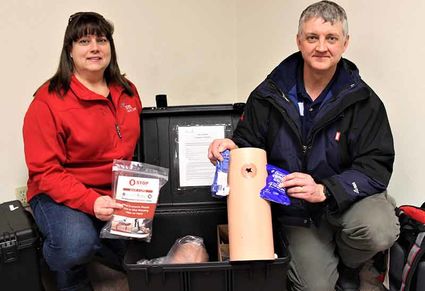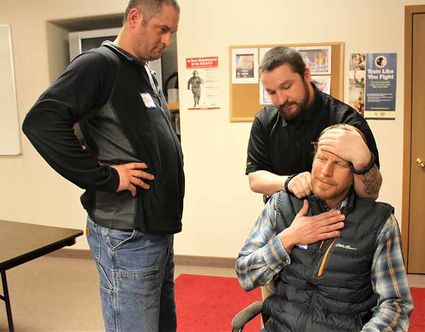Local EMS providers learn new protocols and refine existing skills
February 14, 2018

Dale and Deb Herd pose with educational materials and teaching aids available for a new public course designed to teach citizens without medical training how to stop bleeding. Dale is a Physician Assistant with a Havre clinic. The one hour course, offered free of charge, was the result of recommendations by many emergency and medical groups after the Sandy Hook School shooting in 2012. Northern Montana Hospital in Havre is making materials and aids available for the course.
Thirty local Emergency Medical Service (EMS) providers spent a recent Sunday learning new protocols and skills, practicing and refining existing skills and participating in a Megacode simulation. The class members represented Blaine County ambulance crews from Chinook, Harlem and Turner/Hogeland and Hill County. Other medical personnel who interact with the ambulance crews, including Indian Health Services at Fort Belknap, Sweet Medical Center and Sweet Memorial Nursing Home, also participated. Dan Friede with the Chinook ambulance put the annual training event together.
Friede said the crews do regular training to learn new skills and keep existing skills sharp. Per Friede, "This annual training, which includes other medical providers, allows our ambulance crews to train with other medical professionals they interact with while preparing patients for transport. When the medical people we work with understand what we will do when we arrive to pick up a patient, things seem to go smoother for all of us." The Megacode simulation, which prepares EMS personnel to deal with heart attacks and uses a number of sophisticated training aids, is a major part of the training each year.
The Hartford Consensus and learning to control bleeding
This year trainees heard a presentation by Dale Herd, Physician Assistant from Montana Specialty Medical Center in Havre. Herd presented a one hour program that resulted from The Hartford Consensus. After the Sandy Hook School shooting in 2012 the American College of Surgeons began looking for ways to respond to the growing number and severity of mass casualty events in the U.S. Input from medical groups, the military, the National Security Council, Homeland Security, the FBI, law enforcement, fire rescue and EMS resulted in training recommendations for victims in mass casualty events known as the Hartford Consensus.
A major recommendation from the Hartford Consensus was that "all citizens learn to stop bleeding." In 2013 the "Stop the Bleeding" training was begun. Herd said, "It's a basic course designed for people with no medical experience or training." The Northern Montana Hospital is offering the course and Herd explained, "The folks at this EMS training have skills beyond what is offered in this class. But, we wanted them to take the course so they can, in turn, offer the course in their communities or workplaces." There is no cost to take the course and class materials and training aids are available through the hospital in Havre. Dale Herd and his wife, Deb, are proponents of the training and learned of the program through their military connections.
New protocols for transporting patients with neck, head or spinal injuries
Dr. Carley Robertson, the Medical Control Officer for the Blaine County ambulance crews, gave a presentation about changing protocols for transporting patients with spine-related injuries. Noting that for the last 30 years it has been standard practice for EMS crews to immobilize patients with suspected neck/head or spinal injuries. About five years ago some medical providers began to question the need for so much use of backboards for transportation, noting sometimes the boards interfered with other things that the patient needed during transport. Robertson added, "In our area, often the time we spend preparing a patient on a backboard could be more properly used getting the patient to the nearest next level medical facility. She explained that the new protocols, which she shared, focus more on the needs and condition of each patient tempered with common sense.
One other new program included at this year's EMS training
The participants were assigned to groups, then each group went through the skills practices. This year Dan Friede invited two Blaine County Sheriff Deputies to do a presentation on "personal protection and safety." Asked about the reason for the program, Friede explained, "From time to time we may encounter a patient who is belligerent or aggressive. Often someone who has been abusing drugs or alcohol can present problems for an EMS provider. We wanted our ambulance crews to learn some basic techniques to help protect themselves."
Deputies Billy Minnis and Jim Beemer did the presentation. The techniques they taught were all based on "pressure points." Rather than relying on brute strength, the techniques allow control by applying pressure to certain parts of the body that cause pain. The deputies added, "Someone who is completely under the influence of alcohol or drugs might not respond to these techniques. Pressure points only work when the person can communicate and recognize pain."
Megacode training: responding to heart related emergencies
Megacode training describes how EMS providers are prepared to respond to heart related emergencies. Each year about 1800 Montanans are hospitalized from heart attacks. The EMS annual training uses a simulation of a typical heart related emergency to allow the crews to practice their skills. Friede, who has planned the Megacode training for several years, explained why the training is done regularly. He said, "In a stressful situation, like treating a heart attack victim, we have to automatically respond. Hands-on training helps us internalize the procedures and protocols." Using lifelike mannikins and monitoring devices from the ambulances, trainees respond to changing conditions with their 'patient.'
With a heart attack victim, the main role of the ambulance crew is to prepare the victim for transportation to the next level of care. For most crews in our area, that means to a local hospital at Havre or Fort Belknap. With monitoring equipment on most all ambulances in the county, crews can use the monitoring equipment to assess changing patient conditions and send/receive information about the patient from the hospital where they are headed.
To make the Megacode training realistic, a real person is used for the initial part of the practice. In this case a twenty-something male was complaining of shortness of breath and pain. Like most real situations, a law enforcement officer had arrived first and taken some basic information about the patient. The crew had to decided, on the fly, what roles they would each take as far as assessing the patient's condition, which treatments to begin and how to prepare the victim for transport.

laine County Sheriff Deputy Bill Minnis demonstrates pressure points to local ambulance crew members Josh Nordboe (standing at left) and Ian Davies (seated). Deputies Minnis and Jim Beemer taught EMS volunteers ways to deal with aggressive or belligerent patients.
Some of the practice moves from a real patient to a very sophisticated 'dummy' that can project various symptoms and receive treatments from injections to electric shock to defibrillate a heart. An instructor can change the patient's conditions remotely. Other instructors follow the simulation and help the team do a critique after the exercise is completed. Trainees agree it is a grueling practice but also are convinced of the usefulness of working as a team in a very real, though simulated, set of conditions.
To follow up:
If you are interested in attending or organizing a citizens' "Stop the Bleeding" one hour program, call an ambulance crew member in your area. Or, call Julianne LaSmith, at Havre hospital (262-3146). The whole point of the program is to have citizens prepared to aid victims until trained EMS crews arrive.
Also, if you or someone you know is interested in joining a local ambulance crew, here are some contacts: Steve Leitner for Big Flat (Blaine II), 379-2693 or email at bigflatambulance@gmail.com; for Chinook (Blaine I), Jim Doyle, 357-2335 or email at jdoyle@mt.gov and Laurie Huestis, 357-3310 or email at lhuestis@blainecounty-mt.gov. For Harlem (Blaine III), Karensa Calvert, 353-4637 or email at pixelportrait@itstriangle.com.







